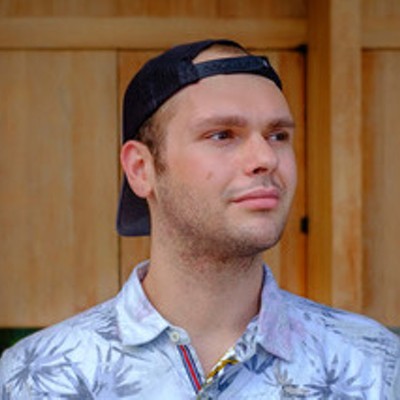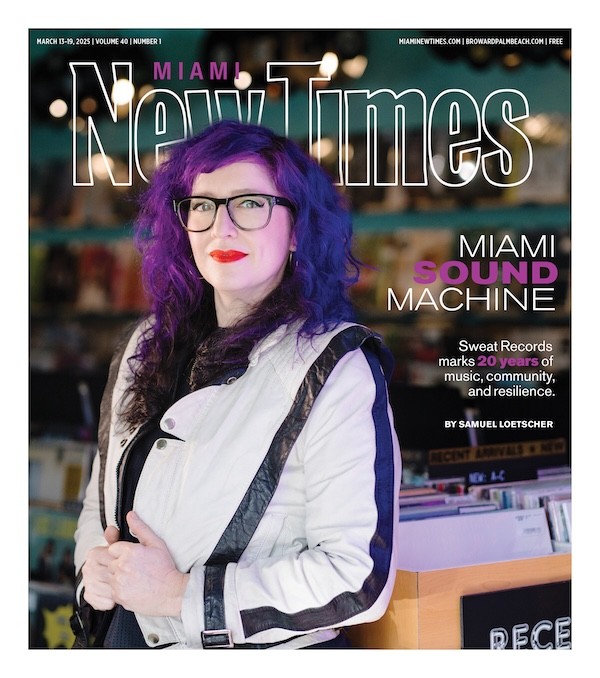"Downtown was the worst place in the world to open a club," Puig says.
He vividly remembers the first year of Club Space. "My memory of the first year is clear because when you do something impactful, you remember everything," Puig recalls, describing time as a rollercoaster.
At the dawn of the new millennium, Puig had taken over a building in Miami's Park West area. Thanks to a deserted — on the verge of blighted — downtown, it was the perfect place to open a nightclub. The City of Miami, at the behest of then Commissioner Art Teele, had designated the area Miami's entertainment district, promising 24-hour liquor licenses to anyone who wanted one. It was an attractive incentive to lure savvy business people unafraid of a challenge — and because downtown was in a state of disrepair 25 years ago, you needed to be downright fearless.
Puig faced many obstacles when he opened Space at its original location at 142 NE 11th St.
"First of all, there was not enough water pressure to flush the toilets in the urinals. We had to hook into a fire hydrant with a hose," he says. "Naturally, the fire hydrant across the street didn't work, so the team had to scour for parts to then hook up a hose, run it across the street, and connect it to the building just to flush the toilets. The building was falling apart; parts of the roof were missing. To fix that was an incredible task."
Even with the building's state, Space's survival depended on that 24-hour liquor license. With downtown mostly empty and Wynwood still a collection of industrial warehouses, South Beach dominated the area's nightlife scene. Convincing clubgoers to cross the causeway was a Herculean task.
"We knew we had to have 24 hours, or else I couldn't compete with Miami Beach," Puig adds. "I like those challenges. The more controversy and the more you throw at me, the more I'm entertained by that. I was building a dream in my head for 20 years before that. Of course, I was worried, too. Is this spaceship going to fly?"

Club Space's first location was at 142 NE 11th St., a block east of the venue's current location.
Louis Puig photo
Making Space
While vacationing in Ibiza in the Eighties, Puig realized Miami could do it better."I started going to Ibiza in 1981," Puig tells New Times. "We would be in a club and say to each other, 'What are we doing here? We have the best clubs.' We would be in an Ibiza club, being uncomfortable and pushed around. The clubs back then still closed at only 5 a.m., and we just kept wondering what we were doing here."
The then-influential Winter Music Conference, which brought droves of DJs and dance music industry folk to Miami every March, was already established. But outside of South Beach, Miami needed a stronghold to keep the music going all day and night by the industry's best.
Puig's entrepreneurial savviness ran in his family. His father opened the acclaimed guayabera store La Casa de las Guayaberas on SW Eighth Street. (Puig still helps run the store to this day.) His DJ career started at 14, with his first official gig at 16. In the Nineties, he dropped out of the University of Miami to be a full-fledged entrepreneur and opened his first club, South Beach's Bar609. Even then, he aspired for something bigger than South Beach could afford. He dreamed of a massive, multi-room warehouse club with an outdoor patio, cutting-edge sound, and a DJ-focused design.
In search of that dream, Puig looked toward downtown Miami, leasing a ramshackle building in the Park West neighborhood. Despite the building's state, Puig could clearly see his vision for a downtown nightclub.
"I saw it built; I saw the people at the bar drinking a vodka Red Bull and dancing," he remembers. "When I showed my business partner George Nuñez at the time the warehouse, he just said, 'Dude, are you nuts?'"
Club Space opened its doors on March 18, 2000, with an already legendary Danny Tenaglia, who held residencies at Twilo and Tunnel in New York City, christening the decks and introducing downtown Miami to the marathon set. "He was the one that helped put Space on the map and the first to start the marathon sets," Puig says. He followed it up by bringing in Marco Carola and Loco Dice to flex their marathon skills with eight-plus hour sets.
Footage of Space's early days exists online, with a video from New Year's Eve 2001 serving as a time capsule of what clubgoers encountered at Space's original terrace. Flags from different nations hung over partygoers as curtains draped the canopies while the crowd danced to Cedric Gervais' "Burning." Ivano Bellini, the terrace's resident DJ at the time, sports a visor and sunglasses as he spins off vinyl and old-school CDJs. His CD case is open and nearby, ready for the perfect mood setter.
At one point, cannons shoot out cryo, quickly cooling down those underneath it as the crowd goes into high energy, punching the sky and jumping. "Man, what memories!" writes one commenter. "I miss those days on the terrace with your amazing sets!"
Puig had installed a patio at the parking lot to serve as a secondary space. "It was a fenced-in parking lot. We just threw in some speakers out there and parachutes for a ceiling," he chuckles, "We would just play music, and people would walk out of the club, scream, and go back in the darkness, not wanting to go outside. They were literally scared of the light."
In 2004, Space moved to its current location at 34 NE 11th St. after the landlord increased the venue's rent. Puig originally wanted it to be Space's home, but it wasn't feasible then, so he settled for the building located a block east.
Leaving It All Behind
After over a decade of late nights and bleary eyes, Puig was ready to move on. In 2013, he sold Space to a group of investors."I was ready to sell. I had my second child and couldn't be here until 4 in the afternoon if I wanted to sustain my relationship with my wife and family. It's a lot of work — even one night working at Space is like working three nights at any other club."
Under the venue's new management, Space fell into irrelevancy. The nightclub had seen better days, and the caliber of talent it booked seemed to have dwindled. It almost seemed like Space's days were numbered.
Then, in 2017, a new group led by David Sinopoli, Coloma Kaboomsky, and Davide Danese took over stewardship of the club. The trio was part of the new guard of event promoters and bookers wringing more cutting-edge DJs and producers to Miami.
Under their leadership, Space flourished. They renovated the club, added fresh talent, and made the terrace feel less like a guilty pleasure and more like a rite of passage — have you ever gone clubbing in Miami if you haven't seen the sunrise at Club Space?

Club Space's terrace in 2003 before the permanent roof was installed to dampen the noise.
Louis Puig photo
On Friday, March 14, Puig will return to the dance institution he built to celebrate Space's 25th anniversary. He'll share the decks alongside Deep Dish and Victor Calderone. In true Space fashion, the celebration continues all weekend, with Marco Carola and Rony Seikaly on March 15 and Mercier, Vanjee, Marten Lou, and Peace Control on March 16.
A nightclub reaching the 25-year milestone is virtually unheard of. It joins the rare ranks of other long-running venues like Womb in Tokyo, Spybar in Chicago, and Berlin's Berghain. Most clubs are content with just surviving their first year.
"I read somewhere that three percent of clubs close in the first year, 50 percent in the first five years, 80 percent in the first ten years, and, get ready, 90 percent close in the first 20, and virtually 100 percent close in the first 25 years," Puig says.
Somehow, Puig had the incredible foresight that Space would last. "I just had this feeling; this 20-year number was in my head."
Deep Dish and Victor Calderone. With Louis Puig, Danyelino, and Sinopoli. 11 p.m. Friday, March 14, at Club Space, 34 NE 11th St., Miami; 786-616-6742; clubspace.com. Tickets cost $10 to $30 via dice.fm.
Marco Carola and Rony Seikaly. With Malóne and Bakke. 11 p.m. Saturday, March 15, at Club Space, 34 NE 11th St., Miami; 786-616-6742; clubspace.com. Tickets cost $15 to $40 via dice.fm.
Francis Mercier, Vanjee, Marten Lou, and Peace Control. With Differ B2B Thunderpony. 11 p.m. Sunday, March 16, at Club Space, 34 NE 11th St., Miami; 786-616-6742; clubspace.com. Tickets cost $10 to $30 via dice.fm.










